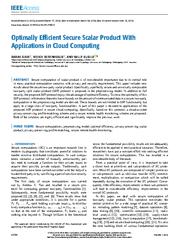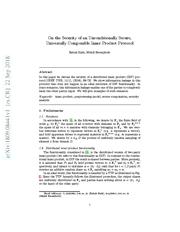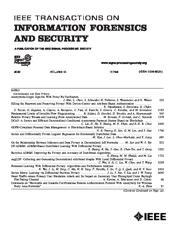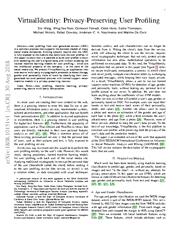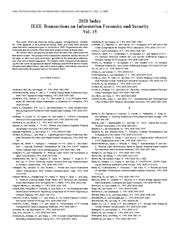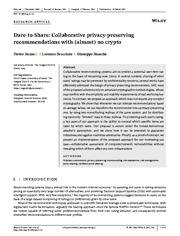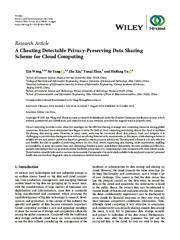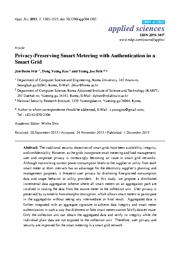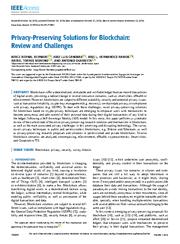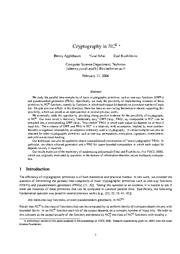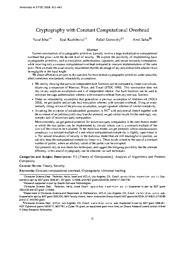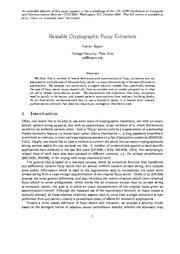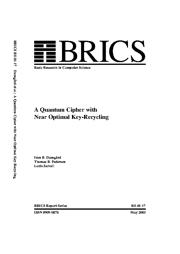A copy of this work was available on the public web and has been preserved in the Wayback Machine. The capture dates from 2021; you can also visit the original URL.
The file type is application/pdf.
Filters
Optimally Efficient Secure Scalar Product with Applications in Cloud Computing
2019
IEEE Access
Specifically, a perfectly secure and universally composable two-party split scalar product (SSP) protocol is proposed in the preprocessing model. ...
INDEX TERMS Secure computations, preprocessing model, optimal efficiency, privacy-preserving scalar product, privacy-preserving profile-matching, secure remote health monitoring. ...
Privacy is also preserved during the query submission and profile-matching phases due to universally composable security of Protocol π SSP . ...
doi:10.1109/access.2019.2908230
fatcat:iafuld6uujcd7cslthwdevkpo4
On the Security of an Unconditionally Secure, Universally Composable Inner Product Protocol
[article]
2018
arXiv
pre-print
In this paper we discuss the security of a distributed inner product (DIP) protocol [IEEE TIFS, 11(1), (2016), 59-73]. ...
In [1] and [2] , various higher level privacy preserving linear algebra protocols are proposed that the DIP protocol is their fundamental building block. ...
Protocol π DDG+ is designed in the preprocessing model and planned to be universally composable and unconditionally secure. ...
arXiv:1809.08441v1
fatcat:ia4a2hrnyfeznhlgecq3i6uekm
Table of contents
2020
IEEE Transactions on Information Forensics and Security
Simplicio 2988 Comments on "Unconditionally Secure, Universally Composable Privacy Preserving Linear Algebra" ................. ......................................................................... ...
Karri 3595 Compressive Privacy for a Linear Dynamical System ............................... Y. Song, C. X. Wang, and W. P. ...
doi:10.1109/tifs.2019.2940363
fatcat:hnt75fw6nbduzh2c4x4wxdsey4
VirtualIdentity: Privacy-Preserving User Profiling
[article]
2018
arXiv
pre-print
pictures with trained support vector machine models in a privacy-preserving manner. ...
We present VirtualIdentity, an application that uses secure multi-party cryptographic protocols to detect the age, gender and personality traits of users by classifying their user-generated text and personal ...
The commodity-based model allows the design of practical, unconditionally secure protocols for many interesting functionalities, for example: inner product [19] , linear algebra [15] , oblivious transfer ...
arXiv:1808.10151v1
fatcat:qizbp7eyevf2xp2wl5c7mqezsm
2020 Index IEEE Transactions on Information Forensics and Security Vol. 15
2020
IEEE Transactions on Information Forensics and Security
Shim, K., TIFS 2020 81-82 Comments on "Unconditionally Secure, Universally Composable Privacy Preserving Linear Algebra". ...
., +, TIFS 2020
3035-3050
Data compression
Compressive Privacy for a Linear Dynamical System. ...
doi:10.1109/tifs.2021.3053735
fatcat:eforexmnczeqzdj3sc2j4yoige
Dare‐to‐Share : Collaborative privacy‐preserving recommendations with (almost) no crypto
2021
Security and Privacy
K E Y W O R D S Pedersen commitment, privacy preserving recommending, risk assessment, risk management, secret sharing, verifiable secret sharing Security Privacy. 2021;4:e153. wileyonlinelibrary.com/journal ...
Since, in several contexts, sharing of other users' ratings may be prevented by confidentiality concerns, several works have effectively addressed the design of privacy preserving recommenders. ...
a secure computation mechanism to facilitate privacy-preserving knowledge transfer. 30 The need for privacy preservation is very important also in the field of social networks, where billions of users ...
doi:10.1002/spy2.153
fatcat:pnlnuwyg7rak3ibhqpsmou4riy
A Cheating Detectable Privacy-Preserving Data Sharing Scheme for Cloud Computing
2018
Security and Communication Networks
In this paper, a data sharing scheme of reliable, secure, and privacy protection based on general access structure is introduced. ...
However, in many cases, users may be concerned about data privacy, trust, and integrity. It is challenging to provide data sharing services without sacrificing these security requirements. ...
There is a close relationship between linear secret sharing scheme and a linear algebraic model called monotone span programs (MSP) [11] . ...
doi:10.1155/2018/6174830
fatcat:jxmh3mtpxzajzcxcah7aolatz4
A privacy-preserving efficient RFID authentication protocol from SLPN assumption
2015
International Journal of Computational Science and Engineering (IJCSE)
In addition, we compare our protocol with other existing HB-like and ordinary RFID authentication protocols according to their construction primitives and security and privacy achievements. ...
Optimal performance requirement, considering storage and computation constraints of low-cost tags, keeping security and privacy policies intact are some major challenges in recent research in this area ...
Definition 5: In linear algebra, a pseudo-inverse A + of a matrix A is a generalisation of the inverse matrix. ...
doi:10.1504/ijcse.2015.068832
fatcat:wod5z4pfe5f7pn6ejld7bl5gi4
Privacy-Preserving Smart Metering with Authentication in a Smart Grid
2015
Applied Sciences
Therefore, user privacy and security are improved for the smart metering in a smart grid network. Appl. Sci. 2015, 5 1504 ...
User privacy is preserved by symmetric homomorphic encryption, which allows smart meters to participate in the aggregation without seeing any intermediate or final result. ...
Data Confidentiality (User Privacy) Symmetric homomorphic encryption, which is used for metering data aggregation, is unconditionally secure, that is, perfectly secure [40] . ...
doi:10.3390/app5041503
fatcat:ubzensiievcb7pi2kxe2jy6z3m
Privacy-preserving solutions for Blockchain: review and challenges
2019
IEEE Access
However, blockchains are subject to different scalability, security and potential privacy issues, such as transaction linkability, crypto-keys management (e.g. recovery), on-chain data privacy, or compliance ...
To deal with these challenges, novel privacy-preserving solutions for blockchain based on crypto-privacy techniques are emerging to empower users with mechanisms to become anonymous and take control of ...
Furthermore, a commitment scheme can be based on, either unconditionally binding (Alice cannot open the commitment value to a different value than the original one) or unconditionally hiding (Bob cannot ...
doi:10.1109/access.2019.2950872
fatcat:kf2rl7onmrbvnozjudspxrcatu
Cryptography in NC 0
[chapter]
2014
Information Security and Cryptography
The existence of OWF and PRG in NC 1 is a relatively mild assumption, implied by most numbertheoretic or algebraic intractability assumptions commonly used in cryptography. ...
Our results make use of the machinery of randomizing polynomials (Ishai and Kushilevitz, 41st FOCS, 2000), which was originally motivated by questions in the domain of information-theoretic secure multiparty ...
Hence, randomized encoding preserves RCCA security. As argued in [12] , RCCA security suffices in most applications of CCA2 security. ...
doi:10.1007/978-3-642-17367-7_4
fatcat:djfjlm7jtzcqbhjehw5td4zhjq
Cryptography in $NC^0$
2006
SIAM journal on computing (Print)
The existence of OWF and PRG in NC 1 is a relatively mild assumption, implied by most numbertheoretic or algebraic intractability assumptions commonly used in cryptography. ...
Our results make use of the machinery of randomizing polynomials (Ishai and Kushilevitz, 41st FOCS, 2000), which was originally motivated by questions in the domain of information-theoretic secure multiparty ...
Hence, randomized encoding preserves RCCA security. As argued in [12] , RCCA security suffices in most applications of CCA2 security. ...
doi:10.1137/s0097539705446950
fatcat:kvyp5t75ifg7bnlw3ivmcdwuum
Cryptography with constant computational overhead
2008
Proceedings of the fourtieth annual ACM symposium on Theory of computing - STOC 08
For natural relaxations of security in the malicious model that are still meaningful in practice, we can also keep the computational complexity linear in s. ...
In the malicious model, we get protocols whose communication complexity is a constant multiple of s and whose computational complexity is slightly super-linear in s. ...
MACs, PRFs and CCA-Secure Encryption The existence of constant-overhead unconditionally secure one-time MACs (message authentication codes) follows immediately from the construction of universal hash functions ...
doi:10.1145/1374376.1374438
dblp:conf/stoc/IshaiKOS08
fatcat:llsycwqmbndejlj57fpvjgvcdy
Reusable cryptographic fuzzy extractors
2004
Proceedings of the 11th ACM conference on Computer and communications security - CCS '04
We characterize the conditions that fuzzy extractors need to satisfy to be secure, and present generic constructions from ordinary building blocks. ...
We propose two particularly stringent security models that specifically address the case of fuzzy secret reuse, respectively from an outsider and an insider perspective, in what we call a chosen perturbation ...
This proves that the JW-DRS construction is unconditionally secure against outsider attacks provided that it is used with a linear code. ...
doi:10.1145/1030083.1030096
dblp:conf/ccs/Boyen04
fatcat:24mmg6dvenbcbmt4kskomwgzpm
A Quantum Cipher with Near Optimal Key-Recycling
2005
BRICS Report Series
Assuming an insecure quantum channel and an authenticated classical channel, we propose an unconditionally secure scheme for encrypting classical messages under a shared key, where attempts to eavesdrop ...
If no eavesdropping is detected, we can securely re-use the entire key for encrypting new messages. ...
The receiver therefore also sends a universal hash function, and privacy amplification is used to extract from the original key a secure key of length 2m + . ...
doi:10.7146/brics.v12i17.21883
fatcat:sjdulhoqizep5dfxto24kaouka
« Previous
Showing results 1 — 15 out of 198 results

